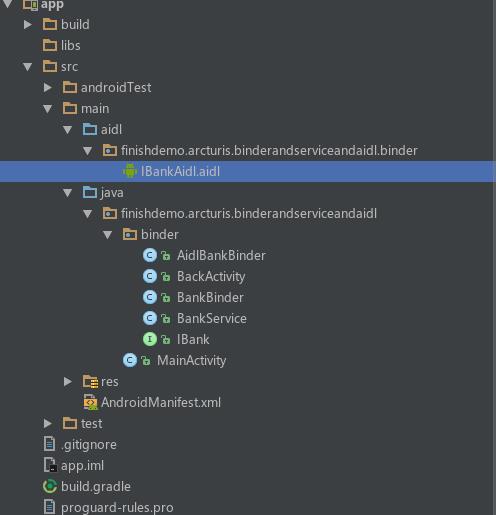android AIDL 语言用法
Posted Arcturis
tags:
篇首语:本文由小常识网(cha138.com)小编为大家整理,主要介绍了android AIDL 语言用法相关的知识,希望对你有一定的参考价值。
跨进程通信可以用AIDL语言
这里讲述下如何使用AIDL语言进行跨进程通信
文章参考 《设计模式》一书
demo结构参考

主要的文件类有:IBankAidl.aidl
java文件:AidlBankBinder,BackActivity(应该是BankActivity写错了),BankService(继承自Service,服务类)
IBankAidl.aidl文件 这里AIdl的使用对包位置有要求,所以我就把包名放出来了
package finishdemo.arcturis.binderandserviceandaidl.binder; // Declare any non-default types here with import statements interface IBankAidl { /** * Demonstrates some basic types that you can use as parameters * and return values in AIDL. */ void basicTypes(int anInt, long aLong, boolean aBoolean, float aFloat, double aDouble, String aString); /** * 开户 * @param name 户主名 * @param password 密码 * @return 开户信息 */ String openAccount(String name,String password); /** * 存钱 * @param money * @param account * @return */ String saveMoney(int money,String account); /** * 取钱 * @param money * @param account * @param password * @return */ String takeMoney(int money,String account,String password); /** * 销户 * @param account * @param password * @return */ String closeAccount(String account,String password); }
AidlBankBinder文件 继承自IBankAidl的Stub类,然后重写并实现Aidl内的方法,这里是模拟一个银行的操作
public class AidlBankBinder extends IBankAidl.Stub { @Override public void basicTypes(int anInt, long aLong, boolean aBoolean, float aFloat, double aDouble, String aString) throws RemoteException { } @Override public String openAccount(String name, String password) { return name+"开户成功!账号为:"+ UUID.randomUUID().toString(); } @Override public String saveMoney(int money, String account) { return "账户:"+account + "存入"+ money + "单位:人民币"; } @Override public String takeMoney(int money, String account, String password) { return "账户:"+account + "支取"+ money + "单位:人民币"; } @Override public String closeAccount(String account, String password) { return account + "销户成功"; } }
BankService文件 返回一个AidlBankBinder
public class BankService extends Service { @Nullable @Override public IBinder onBind(Intent intent) { //单进程写法 // return new BankBinder(); //不同进程AIDL 通信写法 return new AidlBankBinder(); } }
接下来在Activity中使用 BackActivity方法
public class BackActivity extends AppCompatActivity implements View.OnClickListener { // private BankBinder mBankBinder; private IBankAidl mBankBinder; private TextView tvMsg; private Context context; private ServiceConnection conn = new ServiceConnection() { @Override public void onServiceConnected(ComponentName name, IBinder service) { //同一进程写法 // mBankBinder = (BankBinder) service; //不同进程写法 mBankBinder = IBankAidl.Stub.asInterface(service); } @Override public void onServiceDisconnected(ComponentName name) { } }; @Override protected void onCreate(@Nullable Bundle savedInstanceState) { super.onCreate(savedInstanceState); setContentView(R.layout.activity_main); context = this; tvMsg = (TextView) findViewById(R.id.tv_msg); Intent intent = new Intent(); intent.setAction("actionname.aidl.bank.BankService"); //这里遇到一个问题,如果你直接使用intent 这个意图去开启服务的话就会报 //android Service Intent must be explicit 意思是服务必须要显示的调用,这个是5.0之后新的规定 //这个 createExplicitFromImplicitIntent 可以将隐性调用变成显性调用 Intent intent1 = new Intent(createExplicitFromImplicitIntent(context,intent)); bindService(intent1,conn,BIND_AUTO_CREATE); initBtn(R.id.btn_aidl_bank_close); initBtn(R.id.btn_aidl_bank_open); initBtn(R.id.btn_aidl_bank_save); initBtn(R.id.btn_aidl_bank_take); } @Override protected void onDestroy() { super.onDestroy(); unbindService(conn); } private void initBtn(int resID){ Button b = (Button) findViewById(resID); b.setOnClickListener(this); } @Override public void onClick(View v) { switch (v.getId()){ case R.id.btn_aidl_bank_open: //这个RemoteException 是 AIDL跨进程通信的用法必须加上的异常捕获 try { tvMsg.setText(mBankBinder.openAccount("BigAss","123456")); }catch (RemoteException e){ e.printStackTrace(); } break; case R.id.btn_aidl_bank_save: try { tvMsg.setText(mBankBinder.saveMoney(8888888,"bigAss123")); }catch (RemoteException e){ e.printStackTrace(); } break; case R.id.btn_aidl_bank_take: try { tvMsg.setText(mBankBinder.takeMoney(520,"bigAss123","123456")); }catch (RemoteException e){ e.printStackTrace(); } break; case R.id.btn_aidl_bank_close: try { tvMsg.setText(mBankBinder.closeAccount("bigAss123","123456")); }catch (RemoteException e){ e.printStackTrace(); } break; } } /*** * Android L (lollipop, API 21) introduced a new problem when trying to invoke implicit intent, * "java.lang.IllegalArgumentException: Service Intent must be explicit" * * If you are using an implicit intent, and know only 1 target would answer this intent, * This method will help you turn the implicit intent into the explicit form. * * Inspired from SO answer: http://stackoverflow.com/a/26318757/1446466 * @param context * @param implicitIntent - The original implicit intent * @return Explicit Intent created from the implicit original intent */ public static Intent createExplicitFromImplicitIntent(Context context, Intent implicitIntent) { // Retrieve all services that can match the given intent PackageManager pm = context.getPackageManager(); List<ResolveInfo> resolveInfo = pm.queryIntentServices(implicitIntent, 0); // Make sure only one match was found if (resolveInfo == null || resolveInfo.size() != 1) { return null; } // Get component info and create ComponentName ResolveInfo serviceInfo = resolveInfo.get(0); String packageName = serviceInfo.serviceInfo.packageName; String className = serviceInfo.serviceInfo.name; ComponentName component = new ComponentName(packageName, className); // Create a new intent. Use the old one for extras and such reuse Intent explicitIntent = new Intent(implicitIntent); // Set the component to be explicit explicitIntent.setComponent(component); return explicitIntent; } }
主要思路是用隐式的方法启动一个服务,然后调用Aidl实例类的方法即可,具体的Aidl语言在BuildApp之后在

这里即可查看 内部是他实现进程间数据传输所做的转化代码,有兴趣可以看下
以上是关于android AIDL 语言用法的主要内容,如果未能解决你的问题,请参考以下文章